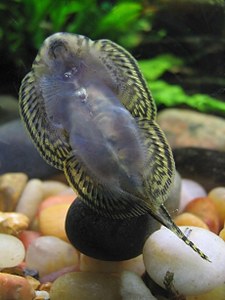Sewellia lineolata
Summary

Scientific Name: Sewellia lineolata (Valenciennes, 1849)
Common name: Gold Ring Butterfly Sucker, Reticulated Hillstream Loach, Tiger Hillstream Loach.
Synonyms: Balitora lineolata (Valenciennes in Cuvier & Valenciennes, 1849:99)
Sewellia lineolata (Hora, 1932)
Sewellia lineolata (Kottelat, 1944)
Distribution: Vietnam.
Sexual Dimorphism: Females plumper than males. Males have raised areas like small "fences" on first few rays of pectoral fins, and when viewed from above are noticeably "squarer" in the area of the front leading edge of the pectoral fins.
(See pictures below).
Maximum size: 2.5 inches
Similar to: Sewellia pterolineata. Also, see: Sewellia sp. "spotted"
Care: Inhabit fast flowing streams over boulders. Aquarium must duplicate these conditions as fish have very high oxygen requirements.With all Sucker-type Hillstream species, care is broadly the same. All need excellent water-flow and aeration, numerous rocky hiding places and smooth pebbles and boulders to graze over. Lighting should be bright to encourage algal growth in the aquarium. Plants are not necessary as the fish do not normally encounter them in the wild, but they will help with water-quality. Suitable plants for high-flow environments are Anubias and Microsoreum. These will grow on rock-work or driftwood.
Feeding: Note these fish have smaller mouths than Gastromyzon species which should be a consideration with foodstuffs. Good quality flake, sinking pellets, algae wafers, thawed frozen Bloodworm, Mysis Shrimp, blanched Spinach, Kale, natural algae an advantage.
See: Hillstream Loaches - The Specialists at Life In The Fast Lane for more detailed explanation.
Water parameters: pH:6.5 - 7.5. Hardness: Medium. Max dh:
Temperature: 68ºF to 75ºF (20-23.8°C)
Breeding: Recently (2006) these fish were bred in aquaria for the first time although the full details of their courtship and breeding methods have yet to be witnessed. (See the discussion in the Loach Forum)

Notes

 Justifiably regarded by most Hillstream Loach enthusiasts as the most beautiful of all species, Sewellia lineolata remains an ambition for many.
Justifiably regarded by most Hillstream Loach enthusiasts as the most beautiful of all species, Sewellia lineolata remains an ambition for many.
When this species was first featured in a photograph that circulated the Internet, it caused an absolute sensation. It took several years before the first fish began to be exported from Vietnam across the world.
This species does not travel well and often shipments may perish in transit. The species very high oxygen requirements means that shippers are learning to pack less fish per bag. This raises the overall freight costs per fish and hence increases the price at the retail level.
If the hobbyist can afford to purchase these fish, they must protect their investment by providing the best quality environment possible. Given these conditions, fish that have survived import will usually settle down and acclimatize well to aquarium life. Once they learn to recognize unfamiliar foods, they will avidly feed on prepared aquarium foods and prosper.
They are a very lively and entertaining species, almost always out on show and having little territorial battles with one another. Occasionally, two males will engage in more heated battles that can continue for some time.
One part of their habits that differs from Gastromyzon or Beaufortia is that of "gliding" on the current. These other species will move from a rock quickly to another in short hops, but Sewellia will launch from an elevated rock or other decor and glide on the current for some distance before alighting on another hard surface, or sometimes the substrate.
Also, unlike many other Sucker-bodied Hillstream Loaches, they seem far more at ease when searching for food on the loose surface of sand or fine gravel, and will flutter their fins, disturbing the surface grains. It appears they do this to uncover possible food items.
For photographs of natural habitat, see: Sewellia lineolata - Natural Habitat and How They Get To Our Aquariums.
Sexual Dimorphism
 |
Recently, we have found that it is quite easy to sex Sewellia lineolata. Like most Sucker-bodied type of Hillstream Loaches, this species Females are somewhat broader in the body than males who have a more streamlined form. Sexually mature Males develop a fringe of small tubercules along the leading edge of the head and the first few rays on the Pectoral fins develop a series of "fences" or louvres, for want of a better description, on their upper surface. The differences are clear in this photograph, also note the shape of the front leading edge of the pectoral fins. The transition between the fin and body is at a much sharper angle in the male, more flowing in the female. |
|
Note this female has no "fences" on the front pectoral rays |
 |
|
While this male has clearly visible differences at the front of the fin. Note also the relative angles of the nose and the arch of the back. The male is overall more streamlined. |
 |
This male is hanging on gamely in a fast current. |
 |
 |
To assist with gripping rocks in a fast current, Sewellia have tiny spines on the underside of the fin rays. |
Photo Gallery
Click to view all images of this species! |
 < Back to Species Index |
Document Actions

